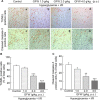Neuroprotection of Gueichih-Fuling-Wan on cerebral ischemia/ reperfusion injury in streptozotocin-induced hyperglycemic rats via the inhibition of the cellular apoptosis pathway and neuroinflammation
- PMID: 27854047
- PMCID: PMC5112181
- DOI: 10.7603/s40681-016-0021-5
Neuroprotection of Gueichih-Fuling-Wan on cerebral ischemia/ reperfusion injury in streptozotocin-induced hyperglycemic rats via the inhibition of the cellular apoptosis pathway and neuroinflammation
Abstract
Background: Risks of stroke link with complications of hyperglycemia. Gueichih-Fuling-Wan (GFW), according to Chinese Medical Code literature, has the promotion of blood circulation and attenuates the swollen plot. Recent pharmacological studies have pointed out its efficacy in patients with cerebral ischemia or diabetes. Therefore, this study determined whether GFW has the protection against cerebral ischemia/ reperfusion (I/R) injury in streptozotocin (STZ)-induced hyperglycemic rats and LPS-induced inflammation in BV-2 microglial cells.
Methods: Extracts of GFW were filtered and frozen to dry for use. Hyperglycemia was induced by intraperitoneal injection of 70 mg/kg STZ. Fourteen days after STZ injection, GFW (1, 2 and 4 g/kg) was orally administered once daily for seven days. Rats were subjected to cerebral ischemia/reperfusion and sacrificed for infarction analysis and neuronal apoptosis detection twenty-one days after STZ injection. MTT assay was used for cell viability; nitrite quantification and western blot analysis of iNOS and COX-2 were used to explore the effects of GFW on LPS-induced inflammation in BV-2 microglial cells.
Results: GFW significantly ameliorated cerebral infarction while dosage was more than 1 g/kg (by 38.03% at 2 g/kg and 52.44% at 4 g/kg), and attenuated neurological deficits by 23.48% (at 2 g/kg) and 47.25% (at 4 g/kg). Furthermore, GFW (2, 4 g/kg) notably decreased TUNEL- and cleaved caspase-3-positive cells in the immunohistochemical stain (P < 0.01 and P < 0.001, respectively). GFW remarkably increased in Bcl-2 and decreased in caspase-3 and Bax/Bcl-2 ratio protein expressions by Western blot. GFW (0.25, 0.5, 1 mg/ ml) significantly reduced LPS-induced NO production in BV-2 microglial cells. And GFW attenuated iNOS and COX-2 expression in LPS-treated BV-2 cells.
Conclusions: In summary, GFW has good bioactivities to protect cerebral I/R injury in hyperglycemic rats, which might be due to inhibition of cellular apoptosis and neuroinflammation.
Keywords: Cellular Apoptosis; Cerebral Ischemia/ Reperfusion Injury; Gueichih-Fuling-Wan; Hyperglycemia; Neuroinflammation.
Similar articles
-
Protection of Gueichih-Fuling-Wan on cerebral ischemia-induced brain injury in rodents is mediated by trans-cinnamaldehyde via inhibition of neuroinflammation and apoptosis.Biomedicine (Taipei). 2024 Jun 1;14(2):38-48. doi: 10.37796/2211-8039.1449. eCollection 2024. Biomedicine (Taipei). 2024. PMID: 38939096 Free PMC article.
-
Guizhi-Fuling-Wan, a Traditional Chinese Herbal Medicine, Ameliorates Memory Deficits and Neuronal Apoptosis in the Streptozotocin-Induced Hyperglycemic Rodents via the Decrease of Bax/Bcl2 Ratio and Caspase-3 Expression.Evid Based Complement Alternat Med. 2012;2012:656150. doi: 10.1155/2012/656150. Epub 2012 Oct 31. Evid Based Complement Alternat Med. 2012. PMID: 23304209 Free PMC article.
-
An-Gong-Niu-Huang Wan protects against cerebral ischemia induced apoptosis in rats: up-regulation of Bcl-2 and down-regulation of Bax and caspase-3.J Ethnopharmacol. 2014 May 28;154(1):156-62. doi: 10.1016/j.jep.2014.03.057. Epub 2014 Mar 29. J Ethnopharmacol. 2014. PMID: 24690773
-
Potential Mechanisms of Guizhi Fuling Wan in Treating Endometriosis: An Analysis Based on TCMSP and DisGeNET Databases.J Ethnopharmacol. 2024 Jul 15;329:118190. doi: 10.1016/j.jep.2024.118190. Epub 2024 Apr 16. J Ethnopharmacol. 2024. PMID: 38614264 Review.
-
A Classic Herbal Formula Guizhi Fuling Wan for Menopausal Hot Flushes: From Experimental Findings to Clinical Applications.Biomedicines. 2019 Aug 18;7(3):60. doi: 10.3390/biomedicines7030060. Biomedicines. 2019. PMID: 31426588 Free PMC article. Review.
Cited by
-
Jingfang granules protects against intracerebral hemorrhage by inhibiting neuroinflammation and protecting blood-brain barrier damage.Aging (Albany NY). 2024 May 28;16(10):9023-9046. doi: 10.18632/aging.205854. Epub 2024 May 28. Aging (Albany NY). 2024. PMID: 38809507 Free PMC article.
-
Population-based cohort study investigating the correlation of diabetes mellitus with pleural empyema in adults in Taiwan.Medicine (Baltimore). 2017 Sep;96(36):e7763. doi: 10.1097/MD.0000000000007763. Medicine (Baltimore). 2017. PMID: 28885331 Free PMC article.
-
Protective effects of Nesfatin-1 peptide on cerebral ischemia reperfusion injury via inhibition of neuronal cell death and enhancement of antioxidant defenses.Metab Brain Dis. 2019 Feb;34(1):79-85. doi: 10.1007/s11011-018-0323-2. Epub 2018 Sep 30. Metab Brain Dis. 2019. PMID: 30269302
-
Dipeptidyl Peptidase-4 Inhibitors Use and Relative Risk of Ischemic Cerebrovascular Disease in Type 2 Diabetic Patients in a Case-Control Study.Front Pharmacol. 2017 Nov 22;8:859. doi: 10.3389/fphar.2017.00859. eCollection 2017. Front Pharmacol. 2017. PMID: 29213240 Free PMC article.
-
Sulfur dioxide reduces hippocampal cell death and improves learning and memory deficits in a rat model of transient global ischemia/reperfusion.Iran J Basic Med Sci. 2018 Oct;21(10):998-1003. doi: 10.22038/IJBMS.2018.29404.7106. Iran J Basic Med Sci. 2018. PMID: 30524672 Free PMC article.
References
-
- Hasso AN, Stringer WA, Brown KD. Cerebral ischemia and infarction. Neuroimaging Clin N Am. 1994;4:733–52. - PubMed
LinkOut - more resources
Full Text Sources
Other Literature Sources
Research Materials





